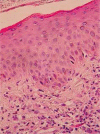Sweet's syndrome with idiopathic thrombocythemia
- PMID: 24683399
- PMCID: PMC3952057
- DOI: 10.5114/pdia.2014.40661
Sweet's syndrome with idiopathic thrombocythemia
Abstract
Diagnosis of paraneoplastic skin syndromes associating neoplastic processes is assumed as the crucial aspect of dermatological practice. Knowledge of clinical findings of dermatoses suggesting coincidence of malignant proliferative processes facilitates diagnostic and therapeutic procedures. We would like to present a case of Sweet's syndrome, qualified for comparative paraneoplastic skin syndromes. Sweet's syndrome, acute, febrile neutrophilic dermatosis, was first described by Robert Douglas Sweet in 1964 as a disorder characterized by fever, skin lesions of erythematous-infiltrative character, leukocytosis with neutrophilia and dense infiltrations of dermis by mature neutrophils. Sweet's syndrome aetiology is not fully understood, although cytokine abnormalities suggest that Th1 lymphocytes play an important role in pathogenesis of the dermatosis. Factors inducing Sweet's syndrome include: haematopoietic hyperplasia; neoplasms: genitourinary, breast, gastrointestinal; infections of the respiratory and alimentary system; inflammatory bowel diseases; drugs; pregnancy and vaccinations. Systemic corticosteroids are the "gold standard" of Sweet's syndrome treatment; potassium iodide or colchicine may also be used. Indomethacin, clofazimine, cyclosporine A and sulfones are the second-line drugs.
Keywords: Sweet's syndrome; acute febrile; neutrophilic dermatosis; paraneoplasia; thrombocythemia.
Figures
Similar articles
-
Sweet's syndrome--a comprehensive review of an acute febrile neutrophilic dermatosis.Orphanet J Rare Dis. 2007 Jul 26;2:34. doi: 10.1186/1750-1172-2-34. Orphanet J Rare Dis. 2007. PMID: 17655751 Free PMC article. Review.
-
Sweet's syndrome: a review of current treatment options.Am J Clin Dermatol. 2002;3(2):117-31. doi: 10.2165/00128071-200203020-00005. Am J Clin Dermatol. 2002. PMID: 11893223 Review.
-
Sweet's syndrome (acute febrile neutrophilic dermatosis).J Am Acad Dermatol. 1994 Oct;31(4):535-56; quiz 557-60. doi: 10.1016/s0190-9622(94)70215-2. J Am Acad Dermatol. 1994. PMID: 8089280 Review.
-
Sweet's syndrome revisited: a review of disease concepts.Int J Dermatol. 2003 Oct;42(10):761-78. doi: 10.1046/j.1365-4362.2003.01891.x. Int J Dermatol. 2003. PMID: 14521689 Review.
-
Acute Onset of Bullous Skin Rash and Acute Kidney Injury after Exposure to Radiocontrast: Sweet's Syndrome.Eur J Case Rep Intern Med. 2023 Mar 13;10(4):003781. doi: 10.12890/2023_003781. eCollection 2023. Eur J Case Rep Intern Med. 2023. PMID: 37051479 Free PMC article.
Cited by
-
Unilateral Arm Urticaria Presenting as a Paraneoplastic Manifestation of Metachronous Bilateral Breast Cancer.Case Rep Oncol. 2016 Jan 14;9(1):33-8. doi: 10.1159/000443661. eCollection 2016 Jan-Apr. Case Rep Oncol. 2016. PMID: 26933416 Free PMC article.
-
Sweet's syndrome with idiopathic epididymitis.Postepy Dermatol Alergol. 2017 Aug;34(4):363-365. doi: 10.5114/ada.2017.69318. Epub 2017 Aug 2. Postepy Dermatol Alergol. 2017. PMID: 28951713 Free PMC article. No abstract available.
References
-
- Outerbridge CA. Cutaneous manifestations of internal diseases. Vet Clin North Am Small Anim Pract. 2013;43:135–52. - PubMed
-
- Sweet RD. An acute febrile neutrophilic dermatosis. Br J Derm. 1964;76:349–56. - PubMed
-
- Cohen PR, Kurzrock R. Sweet's syndrome. A review of current treatment options. Am J Clin Dermatol. 2002;3:117–31. - PubMed
-
- Burgdorf WHC, Plewig G, Wolff HH, Landthaler M. Lublin, Poland: 2010. Dermatologia Braun Falco; p. 513.
-
- McKee PH, Calonje E, Granter SR. Elsevier Mosby; 2005. Pathology of the skin; pp. 679–82.
Publication types
LinkOut - more resources
Full Text Sources
Other Literature Sources



